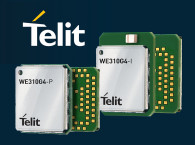
Bluetooth Low Energy technology is ideal for energy-constrained smart sensors and connected devices like wearables, retail beacons, keyless entry systems, smart remote controllers, asset trackers, and industrial and medical monitors. Shipments of IoT products that support Bluetooth Low Energy should increase 34% to 2021 (CAGR), reaching close to 1.4 billion units, according to ABI Research, aided by proliferation of Bluetooth-enabled tablets and smartphones that provide a convenient user interface for interacting with Bluetooth Low Energy devices.
Bluetooth Low Energy devices must ensure energy-efficient operation, including extremely low power consumption in sleep and standby modes that are used frequently to maximize battery life. Strong radio performance is also needed to advertise availability and connect reliably. ST has designed its new BlueNRG-1 programmable SoC with performance and power to satisfy these requirements.
The integrated radio transceiver of BlueNRG-1 is extremely power-efficient in the modes frequently used by devices such as beacons when setting up short-duration connections for exchanges like sharing offers with shoppers’ smartphones. BlueNRG-1’s ability to transition quickly between power-saving and active modes extends battery life from months to years. In addition, RF-output power is boosted to +8dBm to ensure clear and reliable communication for optimum efficiency, even in noisy environments.
“The success of many new applications in the Retail, Connected Home, Automotive, Industrial, Medical, or ePayment segments will notably depend on the quality of user experience, which will demand efficient Bluetooth Low Energy solutions,” explains Benedetto Vigna, Executive Vice President, Analog and MEMS Group, STMicroelectronics. “BlueNRG-1 hits the sweet spot for IoT designers: compared to existing solutions it’s a single-chip solution, neither over-specified nor expensive, and enables longer battery life and superior connection reliability with optimum performance.”
In addition to efficient performance and low power consumption, BlueNRG-1 also offers value-added features that make device designers’ lives easier. These include a dedicated digital-microphone input that simplifies voice-enabled applications and 105°C maximum operating temperature suitable for smart-lighting and automotive applications (such as passive-entry-passive-start or onboard-diagnostic devices). Support for the latest Bluetooth Low Energy version 4.2 specification ensures advanced privacy and security.

The BlueNRG-1 single-core SoC features the 32MHz 32-bit ARM Cortex-M0 and delivers ample performance per milliwatt. 160KByte of on-chip Flash memory provides application-code and data storage besides the possibility to upgrade the ST Bluetooth Low Energy firmware stack. ST has also blended proven ultra-low-power design, including support for fast wake-up and sleep transitions, and sub-1µA standby current.
BlueNRG-1 comes with ST’s market-proven Bluetooth Low Energy stack in the form of a ready-to-use linkable library. Library linking at build-time removes unused parts of the stack so as to ensure efficient memory utilization. Pre-certified profiles for medical devices, proximity monitor and other devices are provided, as well as tools and collaterals that support app development for iOS or Android devices.
Important peripherals that help simplify design and reduce component count include a 10-bit Analog/Digital Converter (ADC), SPI and I2C master/slave units, UART, and up to 15 user-configurable I/Os depending on package type.
BlueNRG-1 can be connected directly to ST’s popular single-chip balun for converting between the balanced transceiver signal and the single-ended antenna signal. Available as a space-efficient QFN device, the balun integrates a network of nine passive components on a single die using ST’s IPD-on-glass technology to deliver space savings, simplify design, accelerate time to market, and enhance radio performance.
Designers using BlueNRG-1 have access to a comprehensive development ecosystem, including a software development kit (SDK) with APIs, sensor drivers, sample applications and more. Recognizing the importance of power consumption in Bluetooth Low Energy applications, there is also a current-estimation tool that helps assess the effects of changing factors such as transmit output power, master/slave sleep clock accuracy, RAM retention, connection advertising or scanning interval, data length, and DC-DC converter activation.
BlueNRG-1 is scheduled to enter volume production in late July 2016 and will be available in 5mm x 5mm QFN-32 and 2.7mm x 2.6mm WLCSP-34 packages.
www.st.com






